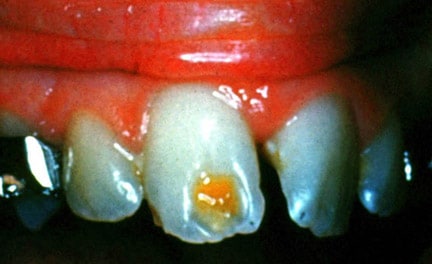Meghan Sullivan Walsh September 9, 2010 Literature Review - St. Joseph/LMC Pediatric Dentistry
Luxation injuries of primary anterior teeth-prognosis and related correlates
Resident: Meghan Sullivan Walsh
Program: Lutheran Medical Center- Providence
Article Title: Luxation injuries of primary anterior teeth-prognosis and related correlates
Authors: Nancy Jo Soporowski, DMD; Elizabeth N. Alfred, MS; Howard L. Needleman, DMD
Journal: Pediatric Dentistry
Month, Year, Volume, Pages: March/April 1994- Volume 16, Number 2, pgs 96-100.
Major Topic: Patterns and prognosis associated with injuries to primary dentition.
Overview of Method of Research: 307 luxation injuries of primary anterior teeth sustained by 222 patients were identified and recorded from a pediatric dental practice. Data was collected from these patients and assessed for patterns involving age, gender, etiology , type of injury, occlusion and sequelae.
Findings: Age: Intrusions were found more common in younger children while older children were more likely to sustain extrusion or luxation injuries. Older children were found treated by extraction more often than younger children who were more likely to receive no treatment. Mean age of luxation injuries was 3.8 years old.
Gender: The majority of patients sustaining injuries were male with a male to female ratio of 1.7/1.
Etiology: Falls were the most prevalent injury accounting for 72% of all injuries followed by bike accidents, sports related accidents and miscellaneous. All luxation injuries were associated with intraoral trauma. Bike accidents were more likely to cause extrusions and luxations while sport related incidents were more likely to cause lateral luxations.
Type of injury: Most luxation injuries were lateral luxations at 57%. The treatment rendered was significantly associated with the severity and type of injury sustained.
Occlusion: The mean overjet of these patients was 3.0mm and a mean overbite of 45.9%. Children with an overjet were more likely to sustain an intrusion injury rather than an avulsion. There were no significant findings regarding an increase in overjet and the risk of sustaining a luxation injury. There did no appear to be any correlation to a patient with a Class II occlusion and the risk of sustaining a luxation injury.
Sequelae: Only 51% of these patients were followed for post-op. Of these patients 55% showed no sequelae, 26% became necrotic, 10% showed calcific degeneration and 8% ankylosed. The best age ranges for survival of these primary teeth were patients under the age of 2 or over the age of 5. This may be due to the approximate age of root closure at 2 years old while the average primary tooth begins root resporbtion at age 5. Repositioning of the teeth was found to increase the risk of pulpal necrosis, however it was noted that this may also be due to the severity of the trauma which calls for the need for repositioning. However, intruded teeth that were repositioned were less likely to become necrotic. There was no significant relationship between type of injury sustained and necrosis and or hypoplasia of the succedaneous tooth.
Key Points: Summary: Majority of pediatric dental emergencies in the primary dentition occur in the maxillary anteriors with males being 1.7 times more likely to sustain an injury. Lateral luxations were most common followed by intrusions and extrusions. Intrusive injuries were more likely to occur in young patients with larger overjets. Root fractures were more common in lateral luxations. More that half of the patients showed no post operative issues while 25 % became necrotic 10% showed calcific degeneration and 8% became ankylosed. Luxated teeth that were repositioned were more likely to develop pulpal necrosis while intruded teeth that were repositioned were less likely to become necrotic. Children with the best post operative results were under the age of 2 or older than 5. There was no correlation between the type of injury and the prevalence of hypoplasia.
Assessment of the Article: This was a great article and evaluation of postoperative trauma cases. Unfortunately all patients were selected from the same office with the same practitioner therefore the numbers and percentages may differ from other similar studies. I was curious as to why this particular office tended to have such a small number of permanent teeth with hypoplasia, 7.7%, when previous studies reported an almost 50% rate of hypoplasia after trauma to the primary dentition.



